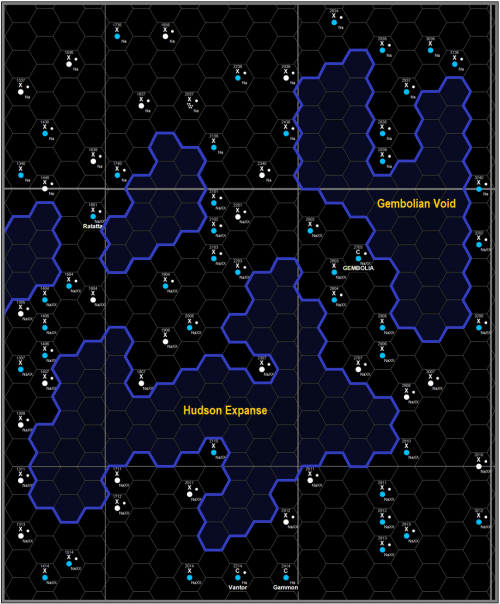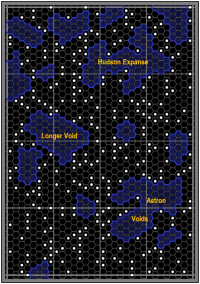Hudson Expanse
The Hudson Expanse is an astrographic feature lying across six subsectors.
- It is located within the coreward part of Astron Sector and the rimward edge of Tsadra Sector.
- It is a rift area of low stellar density.
- It is a barrier to interstellar travel.
Description (Specifications)[edit]
The Hudson Expanse is an area of low stellar density lying mostly within the coreward-trailing quadrant of Astron Sector.
- Other large rifts in the region include the Longer Void to spinward and the Astron Voids to rimward.
The highest tech level commonly encountered out this Far Along (spinward of the Third Imperium) is TL–12, though a few worlds may be more advanced.
- This level of technology allows the routine use of up to Jump-3 drives.
- Locally, areas that cannot be routinely crossed by Jump-3-capable vessels are denoted as rift regions.
The Expanse is considered to have two distinct regions:
- The Hudson Expanse, measuring on average around 6 parsecs coreward-rimward (though individual areas vary in depth) by around 15 parsecs spinward-trailing.
- The Gembolian Void, measuring around 10 parsecs coreward-rimward by around 4 parsecs spinward-trailing and extending into Tsadra Sector.
- The two major regions are surrounded by a number of smaller unnamed void regions.
A basic map showing the Hudson Expanse, the Gembolian Void, and other small unnamed voids.

(Chart sourced from Traveller Map).
The Outer Loop[edit]
A name given to the ring of systems surrounding the Hudson Expanse.
- The Loop systems are only accessible to ships with drives capable of Jump-3 or better.
History & Background (Dossier)[edit]
The Hudson Expanse is a desolate and lonely region, its dark and empty heart fringed by unpopulated, untamed wilderness systems.
- A few deep-frozen rogue worlds may lie within its boundaries.
The first human in the area whose name is known was the colorful Eniri Hudson, a retired bureaucrat turned frontiersman and explorer of the Rule of Man era. Hudson was active around the Expanse ca -1800, kept scrupulous records, and wrote extensively about his travels. He initiated First Contact with the Nibammer of Gembolia and successfully navigated the Outer Loop, no mean feat in the ships of the era. His journals and notes were foundational for the Imperial First Survey.
During his long life Hudson supposedly collected a vast trove of precious minerals and resources, hiding them on an unnamed world somewhere on the Outer Loop and leaving cryptic clues to the precise location within his extensive notes and journals. This probably mythical cache is known as "Hudson's Hoard".
The Hudson Expanse was fully charted during the 300s and 400s, during the Imperial First Survey. Much of the survey's data was drawn from the writings of Hudson, which were at that point more than two millennia old. In 420 the First Survey officially named the region in Hudson's honor.
A reclusive religious group from the Spinward Marches may have settled a few worlds within the Expanse during the early 800s.
The Imperial Second Survey conducted a detailed survey of Charted Space between 995-1065. Their findings confirmed the meticulous accuracy of Hudson's observations.
Timeline[edit]
- ca -1900: The first human explorers are active in the region (Terrans of the Rule of Man).
- ca -1800: Eniri Hudson explores the Expanse.
- 300-420: The Imperial First Survey charts the region.
- 420: The region is officially named.
- Early 800s: Religious refugees fleeing the Imperium may have settled a few worlds along the rifts and voids of the region.
- 995-1065: The Second Survey charts the region.
Worlds & Sectors (Astrography)[edit]
This astrographic feature is found in the following areas:
World Listing[edit]
The systems and worlds associated with these astrographic features are:
References & Contributors (Sources)[edit]
| This article is missing content for one or more detailed sections. Additional details are required to complete the article. You can help the Traveller Wiki by expanding it. |
- Author & Contributor: Lord (Marquis) and Master Scout Emeritus Adie Alegoric Stewart of the IISS

